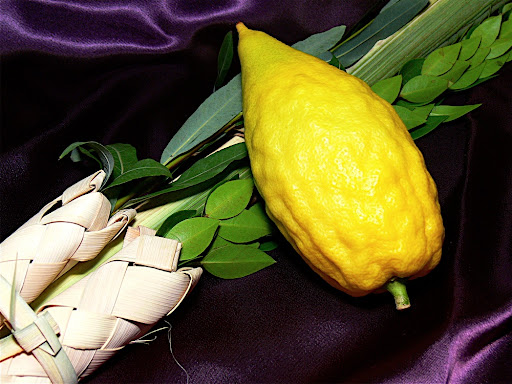
Those of your paying attention to your surroundings will notice some random wooden huts in my fellow Hebraic brothers' backyards. This, my friend, is called the
Sukkah and it's built in observance of the eight day holiday known as
Sukkot. School yourself some more at
Wikipedia if you're so inclined.
In addition to eating meals in the
Sukkah, the Jews carry a yellow fruit and a leafy bunch around with them to synagogue. The tree-like item is called the
Lulav and together with that lemon-looking fruit, called
Etrog, they represent and symbolize man's body.

The longer, thinner leaves, or the
Eruvim, represent man's ability to speak, or the lips. The more oval and lighter green leaves called the
Hadassim represents man's ability to see, or, the eyes. The long bamboo piece in the middle symbolizes the spine. [Stick with me here--almost to the kicks]. And finally, the
Etrog is the heart--see how the shape is similar? By holding all of these things together during certain sections of prayer we're keenly aware of all of our essential functions.
Now let's get to the reason for this long
megillah-- the Sukkot,
Suckas shoes. I made the color palette exclusively in greens, yellow, and browns except for the black laces which has a good reason (to be explained.) First off, the back section is a textured leafy pattern and I also made it a lighter green to match the
Hadassim. The front section of the shoe is a darker green for the
Eruvim and also smoother than the back to differentiate the two different leaves. Dig?
The swoosh has a bumpy yellow leather to match the texture of the fruit and the
midsole has a brown, bamboo-like pattern to match the
crossweave of the
Lulav holder. Tight, right? But here's where the plot thickens. See those leaves coming out of the
midsole? I'm pretty confident in saying that I have never seen a shoe with a decoration coming out from the
midsole--I put some fake
astroturf to symbolize the leaves all around the
circumference shoe. This makes this pair
tres' unique, non?
Finally, about those black laces you all have been wondering about. See, it's tradition that the top of the
Etrog stays on the whole eight days for it to qualify as "kosher." Not "kosher" as in eating, but "kosher as it can be used for prayer purposes.
Those stark black laces represent that piece, or the
Pitum, which, of course, is the final touch that makes these
Suckas kicks absolutely kosher.
 See the pitum at the top? You do? Good!
See the pitum at the top? You do? Good!
















